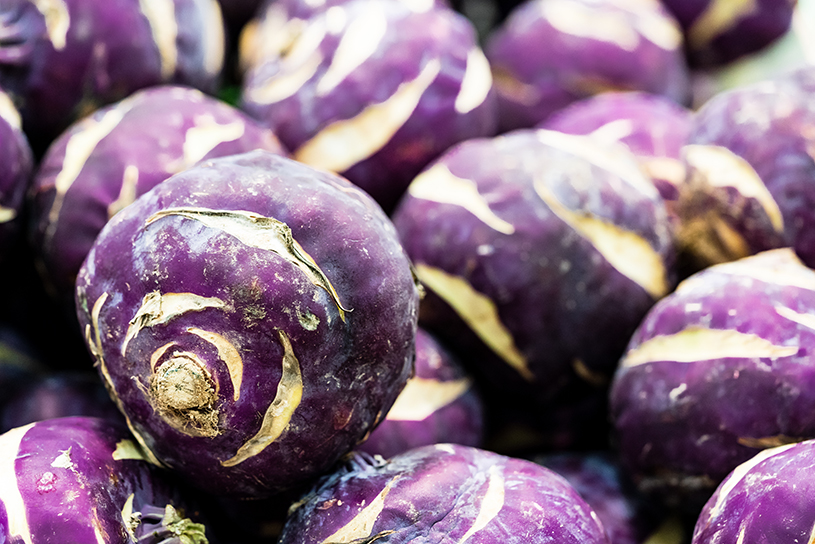What the heck are brassicas, anyways?
Hear the word “brassica” and you might imagine some prehistoric plant or little-known element. In fact, it refers to a genus of plants in the mustard family, also known as cruciferous vegetables. And this nutrient-rich vegetable family is so common, you’re probably already eating one brassica or another every day. From broccoli and cauliflower, to kale and arugula, to radishes and turnips (and let’s not forget cabbage!), the brassica family contains some of our favourite root veggies and leafy greens. And not only are these veggies super popular, they are actually some of the oldest cultivated plants known to man, with some evidence suggesting we’ve been growing them for over 10,000 years.
So what’s so great about the brassica family of veggies? For starters, they are incredibly nutrient-dense. Aside from being pretty darn delicious (in our humble opinion), brassicas are packed with antioxidants, vitamin C, folic acid, potassium and iron – just to name a few. Not impressed? Then put your thinking hat on, because we’re about to get pretty scientific. Most of these cruciferous veggies are high in carotenoids, such as lutein and beta-carotene, that are said to help prevent cancer. And, when chopped up or chewed, they release an enzyme known as “myrosinase,” which helps break down other nutrients into cancer-preventing compounds called isothiocyanates and indoles.
Still with us? Well guess what…we aren’t done yet! Brassicas are also great for maintaining healthy eyesight, thanks to carotenoids like zeaxanthin and lutein. These nutrients help protect your peepers from ultraviolet radiation, and can even prevent damage from the effects of free radicals. Not to mention they’re high in fibre and can help lower bad cholesterol. So…long story short? These veggies are some of the healthiest things you can eat.
No wonder experts recommend you get at least 5 servings of brassicas per week. Not sure which ones to seek out? They’re honestly all good for you, but here we’ll highlight the nutritional values of three of our favourites.
Cabbage

If you’re not already crazy about cabbage, you should be. This cruciferous veggie is often unfairly maligned as filler, possibly because it’s so inexpensive and easy to find year-round. The truth is, this leafy veg has been a staple food since Ancient Greek times. And for good reason. Cabbage is packed with vitamin C, fibre, folate and beta carotene. And it’s so easy to work into your diet. Here are just a few ideas to get you started.
- Add shredded cabbage to your favourite salad
- Toss chopped cabbage into your next stir fry
- Instead of lettuce, use lightly dressed shredded cabbage in your next sandwich or taco
- Looking for a quick side dish? Try a quick vinegar-based coleslaw
Broccoli

Chances are, you’ve been told to eat your broccoli since you were a little kid. And that isn’t stopping anytime soon. Popularized in the early 1900s by Italian immigrants, this mean, green veggie remains one of the most popular brassicas around. And not just that it looks striking and tastes amazing. Broccoli is packed with cholesterol-lowering, digestion-helping fibre, and it’s a great source of B vitamins such as folate and riboflavin. And the list goes on, from beta carotene and lutein to potassium, iron, vitamin C and vitamin K. But the main reason we love this king of the crucifers? Every part is edible, from the pretty florets and leaves to the tender stalk (just strip off the tough outer skin and you’re good to go!). Here are some ideas to get more broccoli in your life:
- Fold sautéed broccoli into your favourite pasta dish
- Toss chopped broccoli with olive oil and roast until crisp for a delicious side dish
- Mix cooked, pureed broccoli with leftover mashed potatoes and veggie stock for a quick and easy soup
- Add finely chopped broccoli to your slaw or salad
Kohlrabi

You’ve probably seen this mysterious, alien-looking veggie at the supermarket and wondered what it is, what it taste likes…and who the heck is buying it. Hopefully by the end of this paragraph, this crisp and tasty veggie will make it onto your grocery list! The hard-to-pronounce name comes from the German words kohl, which means cabbage, and rabi, which means turnip. And “cabbage turnip” is a little bit what kohlrabi tastes like: crisp, delicate, sweet and a little bit peppery. Like most of its cruciferous counterparts, this tasty veg is loaded with fibre, potassium and vitamin B6 – not to mention vitamin E, which is usually only found in higher fat foods. Here are a few ways to try this under-appreciated veg.
- Add peeled, shredded kohlrabi to your coleslaw
- Steam or boil kohlrabi and mash with garlic and olive oil
- Mix thin slices of kohlrabi with apple, lemon juice, olive oil, fresh herbs and toasted nuts or seeds for a fresh, light salad
- Add sliced, peeled kohlrabi to your crudité platter
Impressed? That’s just three of the many amazing veggies in this family. We love them all, and we encourage you to experiment and find your faves. To get to your recommended dose of 5 servings per week, why not pick out a different brassica every time you’re at the store? You could be eating roasted turnips one day and a shredded kale salad the next. But whatever you cook up, we guarantee it’ll make you feel amazing.
What’s your favourite brassica? Let us know at blog@madradish.com!


